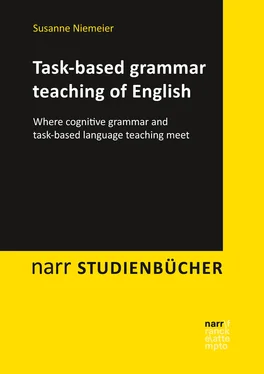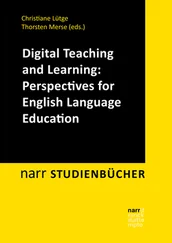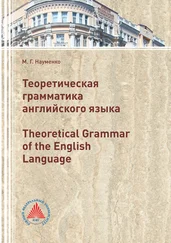R. ELLIS (2003: 29) mentions that “implicit in PPP is the idea that it is possible to lead learners from controlled to automatic use of new language features”. However, such use would normally still be decontextualised, i.e., it is not pragmatically anchored in a specific usage context. R. ELLIS continues his convincing arguments against the PPP approach by criticising that “PPP views language as a series of ‘products’ that can be acquired sequentially as ‘accumulated entities” (ibid.), that “SLA research has shown that learners do not acquire a language in this way” (ibid.) and that “L2 acquisition is a ‘process’ that is incompatible with teaching seen as the presentation and practice of a series of ‘products’” (ibid.). Furthermore, PPP is a very teacher-centred approach and the learners normally only react to the teacher’s and/or the coursebook input, but do not become the pro-active and collaborative learners which they are meant to be from a more modern perspective, which is also the perspective of task-based language teaching.
Grammar is an omnipresent phenomenon in the foreign language classroom and it is generally not liked too much, neither by the learners nor by the teachers. Learning to master a foreign language certainly involves learning (about) the grammar of this language as well, however, there are many different opinions on what ‘grammar’ actually is. Most people would probably say that the term relates to the structural aspects of language and they would contrast it with the notion of ‘vocabulary’. Indeed, when it comes to the competences to be acquired in foreign language teaching, most current EFL textbooks still differentiate between ‘vocabulary’ and ‘grammar’ / ‘structures’ in their tables of contents. Cognitive grammar, on the other hand, argues that lexis and grammar are inseparably intertwined and form two ends of a continuum, sharing many organisational principles (such as categorisation, (un)boundedness and metaphorization, among others) – this is explained in more detail in the third chapter.
Language cannot be defined without these two poles of the continuum. If there was only vocabulary, people would run around and utter single words – and this is certainly not what is meant by “communication”. If there was only grammar and no words, nothing could be said or even thought at all. Both ingredients are necessary and work together. Even a very simple sentence like “Mary runs” does not only contain words, but is full of grammar as well. On the one hand, the sentence follows the English word order in that the subject is placed before the verb. As the verb is intransitive in its motion meaning1, it cannot have an object. Furthermore, the sentence is tensed (third person singular present tense) and the non-use of the progressive aspect states that the sentence does not describe an ongoing activity but instead a habitual one, as Mary may be a member of a running team with regular running meetings, or that Mary always runs when under stress, for example. What is still more, the sentence talks about reality, as otherwise modal auxiliaries would be used ( Mary could run , Mary may run , Mary ought to run etc. – all of them indicating various extents of distance towards reality and all of them indicating that it is not a proven fact that Mary runs).
Therefore, even in the very first English lessons for beginning learners, in which simple sentences such as the one mentioned above are used on a regular basis, grammar is an ever-present asset and contributes a lot to the meanings of the utterances made, although in a more abstract way than vocabulary does. This is why grammar should never be neglected in the foreign language classroom and why learners need to be made aware of the meaning components that grammar contributes to the overall meaning of an utterance. Although WIDDOWSON (1990: 97) correctly argued already thirty years ago that “language learning is essentially learning how grammar functions in the achievement of meaning”, this sound piece of advice has hardly been accepted and grammar has rather been taught “for grammar’s sake”.
1.2 A brief history of grammar teaching
Over the history of second language acquisition theories, the importance of grammar instruction has varied quite extensively, from playing a key role to being of hardly any importance, depending on the theories that were fashionable at certain times. The following paragraphs briefly elucidate in a simplified way the major theories on second language acquisition with respect to the role that grammar plays in them.
Foreign languages have been taught since the Middle Ages, when Latin and Ancient Greek were the languages to be learnt. When at a certain point of time foreign language teaching no longer focused on the teaching of ancient languages that were no longer spoken but turned towards modern languages instead, the way of teaching foreign languages did not change but was simply taken over from the teaching of the classical languages. This first approach to the teaching of modern foreign languages was called the ‘Grammar-Translation Method’ – definitely a misnomer, as a method needs a theory behind it, which was absent in this case.
Similar to the teaching of classical languages, the language of instruction for the modern languages was usually the learners’ mother tongue, and when learners left school after many years of foreign language instruction they were in most cases utterly unable to hold a conversation in the foreign language, as this had usually never happened in the classroom, in which the focus was nearly exclusively on written and not on spoken language. Sophisticated texts were read and translated in class and grammar structures in these texts were explained and discussed, not with the aim to prepare the learners for being able to communicate with native speakers of the foreign language but with the aim of acquainting the learners with the literature of the foreign culture and educating them to be persons with a taste for what was seen as ‘high culture’ in those days.
The aim of language education was not to enable the learners to use the foreign language, but education was rather seen as ‘cultivation’. Furthermore, grammar analysis was meant to train the learners’ capacity for logical thought. Language was thus not used as an everyday communicative tool but dissected in a quasi-academic way. As communication was of no special interest, grammar played a decisive role in this type of instruction. Interestingly enough, this way of foreign language instruction is still popular in wide parts of the world (cf. also NUNAN 2015: 8).
Although criticism of the Grammar-Translation Method came up relatively early, nothing much changed until World War II, during which the necessity for people to actually speak foreign languages became vital. New methods, among them what VANPATTEN/WILLIAMS (2013: 17) call the “Army method”, were developed, which were meant to lead the learners towards an ability to really speak the language in question. This was partly inspired by the thought that the enemy should be understood, partly inspired by the wish to send diplomats and soldiers or even smuggle spies into a foreign country who had to speak the foreign language flawlessly in order not to be detected, and certainly also inspired by the wish for a teaching method which focused more on oral production than on reading, analysing, translating and interpreting classic literature.
The so-called Audiolingual Approach, based on behaviouristic theories of conditioning via stimulus-response, was therefore developed in the USA, but reasonably quickly also found its way to Germany. In the 1970s, many German schools invested heavily in language laboratories, in which the learners were sitting in single cubicles, listening with headphones to tapes playing sample sentences of the foreign language. They were expected to repeat the sentences they heard and transform them in so-called ‘pattern drills’. The teacher could listen in to every single one of the learners and could also correct them. This way of teaching focused on oral production, repetition and automatization. Grammar was ‘performed’ in these pattern drills, where, for example, an active sentence was presented which the learners had to transform into a passive sentence, but the transformation was not explained any further. Therefore, the importance of grammar in this approach was rather minor, as the students were expected to learn from analogies and as an explicit analysis of grammatical phenomena did not happen. The method relied instead on the automatization of a grammatical structure by repetition, i.e., by ‘habitualisation’: whenever the learners heard a specific stimulus, they were expected to give a conditioned response.
Читать дальше












